

History - Historic Figures: Nicholas II (1868-1918) World History: Russia: Rasputin. Rasputin, the Monk Who Brought Down a Dynasty by Jennifer Brainard An unwashed sexually promiscuous peasant helped to bring down the empire of the Tsars in Russia.
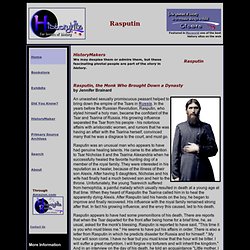
In the years before the Russian Revolution, Rasputin, who styled himself a holy man, became the confidant of the Tsar and Tsarina of Russia. His growing influence separated the Tsar from his people - his notorious affairs with aristocratic women, and rumors that he was having an affair with the Tsarina herself, convinced many that he was a disgrace to the court, and must go. Rasputin was an unusual man who appears to have had genuine healing talents.
He came to the attention to Tsar Nicholas II and the Tsarina Alexandria when he successfully healed the favorite hunting dog of a member of the royal family. Rasputin appears to have had some premonitions of his death. He was advised by a friend that there was a plot against his life, and that he shouldn't go out that night. Stalin's Cult of Personality. Stalin is also known for building an unprecedented cult of personality.
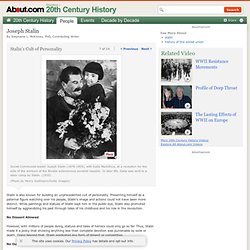
Presenting himself as a paternal figure watching over his people, Stalin's image and actions could not have been more distinct. While paintings and statues of Stalin kept him in the public eye, Stalin also promoted himself by aggrandizing his past through tales of his childhood and his role in the revolution. No Dissent Allowed However, with millions of people dying, statues and tales of heroics could only go so far. Thus, Stalin made it a policy that showing anything less than complete devotion was punishable by exile or death. No Outside Influence Not only did Stalin readily arrest anyone remotely suspected of having a different view, he also closed religious institutions and confiscated church lands in his reorganization of the Soviet Union.
No Free Press. Stalin's Five Year Plans. Stalin's willingness to use brutality to achieve political aims was well established by the time he took power; nevertheless, the Soviet Union (as it was known after 1922) was unprepared for the extreme violence and oppression that Stalin unleashed in 1928.
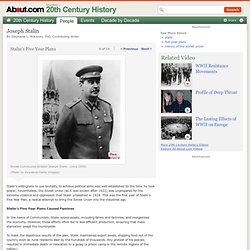
History - Historic Figures: Joseph Stalin (1879 - 1953) History - Historic Figures: Vladimir Lenin (1870 - 1924) Russian Revolution — History.com Articles, Video, Pictures and Facts. Mr Donn's Lesson Plan - Start of the Russian Revolution. Lesson Plan for World History (3-4 days) Russian Revolution Critical Thinking Skills Grade 9 Social Studies Don Donn; USA Break the students into 5 groups.

Have the students research the lives of the following 5 people: Czar Nicholas II Rasputin Alexander Kerensky V.I. Lenin Lev Trotsky If you have a larger class or if you want smaller groups you can add Alexandra (Czarina) and Anastasia. Students are to determine as a group the pivotal or turning point of their lives from their research. The pivotal moment can be either a personal pivotal point or a pivotal point for the country.
The group will then create a short one-act/one scene play about that pivotal moment and perform it in front of the class. Have the group turn in to you a written copy of the play including dialogue and stage (movement) directions. This lesson is a lot of fun. At the end of their "act", have each group explain why they chose that scene as their pivotal moment. Leon Trotsky Biography. Early Life Leon Trotsky was born Lev Davidovich Bronstein in Yanovka, Ukraine—in the Russian Empire—on Dec 7, 1879.
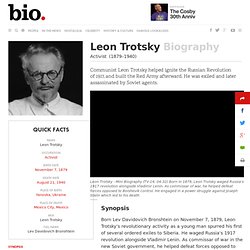
His parents, David and Anna Bronstein, were prosperous Jewish farmers. When he was 8 years old, Trotksy went to school in Odessa, then moved in 1896 to Nikolayev, Ukraine, for his final year in school. While there, he became enthralled with Marxism. In 1897, Trotsky helped found the South Russian Workers' Union. Gulag. The Gulag (Russian: ГУЛаг, tr.

GULag, IPA: [ɡʊˈlak] ( "GULag" was the acronym for Гла́вное управле́ние лагере́й и коло́ний (Glavnoye upravleniye lagerey i koloniy), the "Main Camp Administration". One Day in the Life of Ivan Denisovich: Context. Alexander Isaevich Solzhenitsyn was born on December 11, 1918, in the Russian town of Kislovodsk, one year after the Communist revolution of 1917.
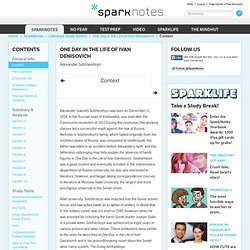
During this revolution, the working classes led a successful revolt against the tsar of Russia, Nicholas II. Solzhenitsyn’s family, which hailed originally from the southern plains of Russia, was composed of intellectuals. His father was killed in an accident before Alexander’s birth, and this fatherless upbringing may help explain the absence of family figures in One Day in the Life of Ivan Denisovich. Solzhenitsyn was a good student and eventually enrolled in the mathematics department of Rostov University. Key Players. Key Players Vladamir Lenin A native born Russian citizen, Lenin can be considered one of the most poignant and influential players within the Russian Revolution. An attorney by trade Lenin spent the years prior to the revolutionary movement, and after his banishment from Russia in 1895 for treason, traveling Europe. During this time Lenin made ties with various social democrats including Georgy Plekhanov of Siberia, Nadezhda Krupskya his future wife, and Julius Martov would eventually come to be his opponent.